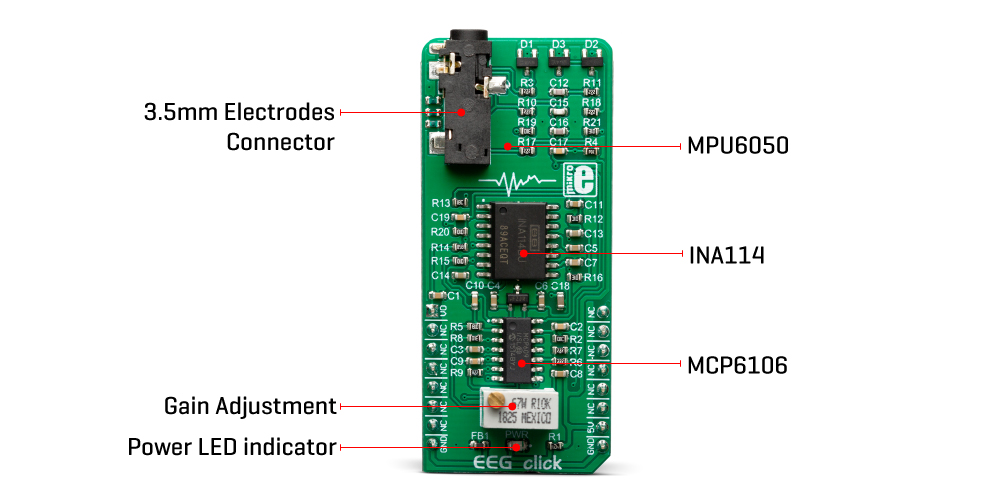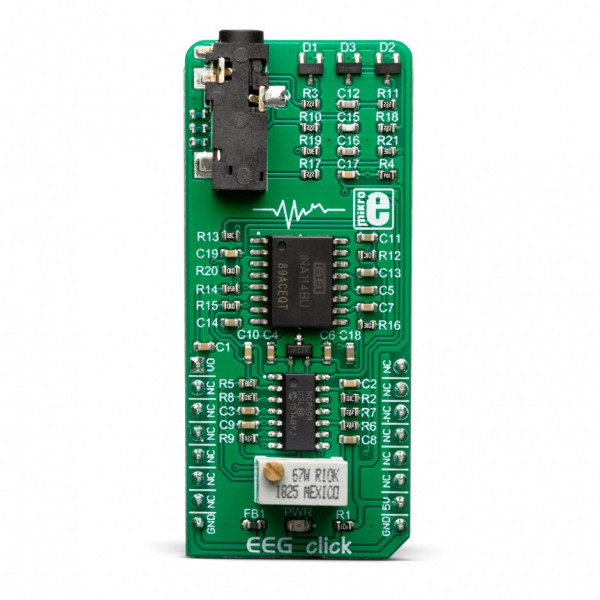Prices incl. GST
Out of Stock.
- Product Code: MIKROE-3359
- MPN: MIKROE-3359
Monitoring brain activity gains its popularity lately, as due to the fact that many commercially available integrated circuits emerge on market, almost daily. High-performance instrumentation amplifier ICs are affordable, making applications such as EEG click possible. EEG training, a technique of mental training method which makes the trainee consciously aware of the general activity in the brain is one of the applications where EEG click can be very useful. It can be also used for experimentation and development of brain-machine interface applications, or for simple monitoring of the brain activity.
What is EEG?
Electroencephalography is a method used to record the electrical activity of the brain. This is a non-invasive method which uses a number of electrodes placed along the scalp. EEG measures voltage fluctuations which appear as a result of the ionic currents within the neurons of the brain. The measurement can be focused either on event-related potential changes (ERP) or on spectral content of the signal, collected during a certain period. EEG is most often used to diagnose epilepsy, which causes abnormal changes of EEG readings.
How does it work?
EEG click is a single channel EEG monitoring device, based on the INA114, a precision instrumentation amplifier (IA) by Burr Brown®, a division of Texas Instruments, specialized in high-performance analog and mixed signal ICs. This IC offers a very low noise, LASER trimmed offset voltage, and very good common-mode rejection ratio. It uses a single resistor to set up its gain, which can easily be set up to 10,000. On this Click board™, the INA114 IA has its gain set to about 12 times. Further amplification and signal filtering is done by the MCP609, a four-channel op-amp from Microchip, so that the final gain factor is about 7800 times. Such high amplification is necessary in order to amplify very faint voltages generated during the brain activity. To fine-tune the amplification, there is a multi-turn precision potentiometer which allows to set the gain of the intermediate amplification stage between 10 and 100 times.

Since the "brain waves " can be both positive and negative, EEG click uses a virtual GND at the potential of 2.048V. This also helps reducing the noise from the common GND, improving the readings quality. The amplified brain activity signal is available at the AN pin of the mikroBUS™, allowing sampling by the host MCU.
EEG measurements should be ideally conducted in an electrically isolated room, since any type of electromagnetic interference (EMI) could corrupt the measurement data. However, the INA114 offers some EMI protection, as it features an extremely good common-mode rejection ratio (CMRR), allowing to successfully cancel out most of induced interferences.
This Click board™ uses 3-electrode setup, which can be connected over a 3.5mm Jack connector on the Click board™. Although the best results can be achieved by using silver-chlorine plated electrodes, any type of electrodes can be used. EEG uses the DRL electrode placement scheme: two electrodes are placed behind the ears, while the third electrode is placed on the forehead. The DRL electrode (on the forehead) helps eliminating the common voltage, while two other electrodes are connected to the differential inputs of the INA114 IA.
The complete signal path is very well protected against voltage spikes and transients, that might appear as a result of the electrostatic discharge (ESD) in contact with the human body, so there is a set of ESD suppressing diodes and TVS diodes, which prevent sensitive IA and operational amplifiers on its output to become damaged by ESD events.
Specifications
| Type | Biomedical |
| Applications | EEG click can be used in EEG biofeedback mental training, for experimentation and development of brain-machine interface applications, or for simple monitoring of the brain activity. |
| On-board modules | INA114, a precision instrumentation amplifier (IA) by Texas Instruments; MCP609, a four-channel operational amplifier from Microchip; MAX6106, a 2.048V reference from Maxim Integrated. |
| Key Features | ESD and EMI protection of the inputs, compatible with several types of electrodes, high-precision instrumentation amplifier with high CMRR, gain regulation, etc. |
| Interface | Analog |
| Input Voltage | 5V |
| Click board size | L (57.15 x 25.4 mm) |
Pinout Diagram
This table shows how the pinout on EEG Click corresponds to the pinout on the mikroBUS™ socket (the latter shown in the two middle columns).
Onboard Settings And Indicators
| Label | Name | Default | Description |
|---|---|---|---|
| PWR | PWR | - | Power LED indicator |
| CN1 | 3.5mm JACK | - | 3.5mm electrodes connector |
Software Support
We provide a library for the EEG Click on our LibStock page, as well as a demo application (example), developed using MikroElektronika compilers. The demo can run on all the main MikroElektronika development boards.
Library Description
Library only initializes GPIO interface. For more details check documentation.
Examples description
The application is composed of the three sections :
- System Initialization - Initializes peripherals and pins.
- Application Initialization - Initializes ADC and timer interrupt function.
- Application Task - (code snippet) - Reads ADC value and sends results on serial plotter every time when interrupt occurres.
void applicationTask()
{
if (interrFlag == 1)
{
interrFlag = 0;
readADC = ADC_Get_Sample( 0 );
timeRead = interrCnt * time_ms;
plotRes( readADC, timeRead );
}
}
Additional Functions :
void initTimer()- Initializes interrupt time to the desired value.void plotRes( uint16_t plotData, uint32_t plotTime )- Sends ADC data on the serial plotter.
The full application code, and ready to use projects can be found on our LibStock page.
Other mikroE Libraries used in the example:
ConversionsUARTADC
Additional notes and informations
Depending on the development board you are using, you may need USB UART click, USB UART 2 click or RS232 click to connect to your PC, for development systems with no UART to USB interface available on the board. The terminal available in all MikroElektronika compilers, or any other terminal application of your choice, can be used to read the message.
MIKROSDK
This click board is supported with mikroSDK - MikroElektronika Software Development Kit. To ensure proper operation of mikroSDK compliant click board demo applications, mikroSDK should be downloaded from the LibStock and installed for the compiler you are using.









